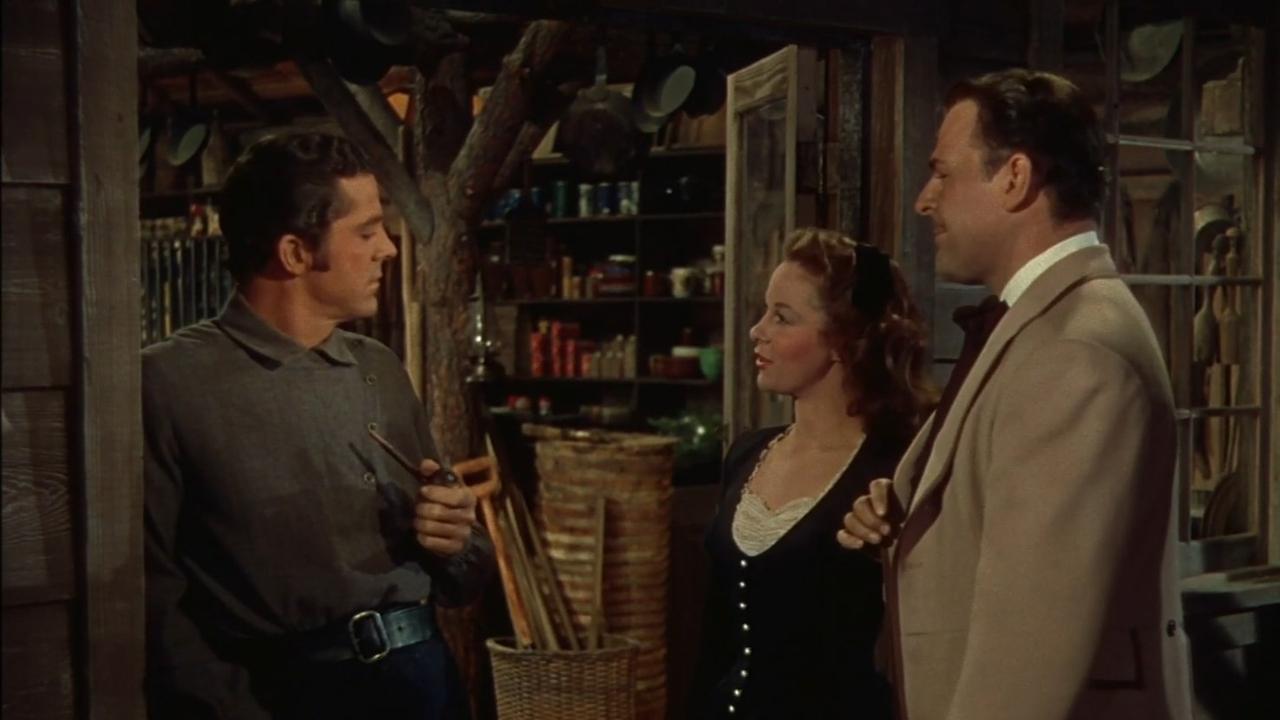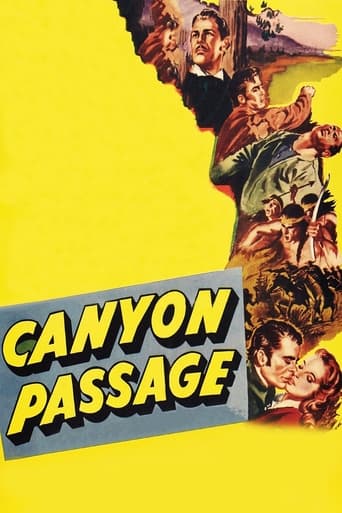

This excellent , meaty Western contains interesting plot ,thrills , brawls , shoot'em up and is quite entertaining . A great Western with some impressive action and spectacular scenario .It deals with businessman Logan Stuart (Dana Andrews) who falls for Lucy who happens to be the fiancee of his friend , banker/gambler Camsrose (Brian Donlevy) . Then Logan is torn between his love of two very different women (Susan Hayward , Patricia Roc) in 1850's Oregon and his loyalty to his friend who gets into money troubles . There is also a nasty villain called Bragg (Ward Bond) who takes on Logan and a thrilling battle against Indians . Every Exciting Character ! Every dangerous moment ... Rip-roaring Western set in Oregon territory , Portland , 1856 . Moving Western including colorful exteriors , fist-fight between Dana Andrews and Ward Bond as well as a pulsating and violent Indian raid and tuneful melodies . Adding some unforgettable scenes as the building a house carried out the neighborhood similarly many years later in ¨Witness 1985 by Peter Weir . Dana Andrews delivers a sober acting as a former scout turned store owner . Brian Donlevy gives a fine interpretation as a compulsive gambler friend who goes over the line. Hoagy Carmichael that appears as a top-hatted role aptly named Linnet , chirping some songs that include the memorable Buttermilk sky . Carmichael serves as the wandering ministrel to the action . Support cast is frankly excellent , such as : Fay Holden , Andy Devine , Stanley Ridges ,Onslow Stevens , Rose Hobert , Chief Yowlachie , Ray Teal and Lloyd Bridges .Sensitive as well as catchy score by maestro Frank Skinner , including four songs sung by Carmichael . Strikingly filmed in color by Edward Cronjager . Being lavishly produced by Walter Wanger and associate producer : Alexander Golitzen , a prestigious production designer . Based on the homonymous novel by Ernest Haycox , the picture was well directed by Jacques Tourneur who was best known for his horror films .The underrated filmmaker Jacques Tourneur , though the present-day he is better considered , he was a prolific craftsman who directed some masterpieces . Jacques directed all kinds of genres , such as Terror : ¨Curse of demon¨, ¨I Walked with a Zombie¨, ¨Leopard man¨ , ¨Cat people¨, ¨Comedy of terrors¨ ; Film Noir :¨Out the past¨, ¨Berlin express¨, ¨Experiment perilous¨ , ¨Nightfall¨ and Adventure : ¨The giant of Marathon¨ , ¨Tombuctú¨, ¨Martin the gaucho¨ , ¨Anne of the Indians¨ and ¨The flame and the arrow¨.In Western genre he made 5 films : This masterpiece titled ¨Canyon passage¨(1946) , ¨Star in my Crown¨(1950) , ¨Stranger on horseback¨, also with Joel McCrea , ¨Wichita¨(1955) with Joel McCrea as Wyatt Earp formerly to OK Corral duel and ¨Great day in the morning¨ with Robert Stack dealing with facing Union and Confederation . He finally directed episodes of ¨Norhwest passage¨ (1958) titled Frontier Rangers , Fury River and Mission of danger . Rating : 7.5/10 , Well worth watching
... View MoreWhile at RKO Pictures, French expatriate Jacques Tourneur directed three low budget horror films for producer Val Lewton: "Cat People" (1942), "I Walked With A Zombie" and "The Leopard Man." (1943). All three are still considered to be classics of their kind. In 1947, he directed "Out Of The Past" starring Robert Mitchum, Jane Greer and Kirk Douglas. So by rights, "Canyon Passage" should have been a superior Western. It had everything in its favour, a very good director, a top-notch crew and a script based on a novel by Ernest Haycox which was adapted for the screen by Ernest Pascal. The photography was by veteran Hollywood cameraman Edward Cronjager. Frank Skinner wrote the music. Singer songwriter and sometime actor, Hoagy Carmichael performed "Ole Buttermilk Sky" in the film that he composed with Jack Brooks and was a big hit in its day. Sadly I found the film a distinct disappointment, let down in great part by the wooden performances of the two male leads: Dana Andrews as Logan Stuart, a merchant cum entrepreneur, and Brian Donlevy as George Camrose, his gambling addicted erstwhile business partner. It's a moot point whether this is the fault of a weak script, an inattentive director or bad acting,but the fact remains "Canyon Passage" is a lesser film because of it. Thankfully, the film manages to rise somewhat above your average 'horse opera' thanks, in no small part to Susan Hayward as Lucy Overmire, George Camrose's fiancee, British emigre, Patricia Roc as Logan's girlfriend, Caroline Marsh, and a strong performance by a stalwart of John Ford's films, Ward Bond. Such solid actors as Lloyd Bridges, Rose Hobart, Stanley Ridges and Halliwell Hobbes, in turn ably supported them. "Canyon Passage" is a modest attempt to portray what life was like on the Oregon Frontier, and is still worth watching.
... View MoreDecidedly Offbeat Western with an Innocuous Title but Otherwise a Winner in All Respects. The Stylist Director Tourneur Brings a European Sensibility to the Hollywood Pioneer Picture Mainstay and Makes It Something Special.The Gorgeous Technicolor is a Surprise for Fans Turning to This Genre Piece and There are More Surprises to Come. The Complex Plot with Subplots Galore, the Mixing of the Community with Many Mixed Up Citizens, the Brutal Saloon Fist Fight Complete with Dripping Skull Fractures, the Indian Raids that Show Some Savage Behavior (although in long shot), and There's More.The Score from Frank Skinner Works Quite Well and Hoagy Carmichael is Along for the Ride with His Own Brand of Warbling. Ward Bond Plays a Very Heavy Heavy in One of His Best Villain Roles. The Two Lead Men Dana Andrews and Brian Donlevy Do Nothing to Detract from the Overall Magnificence of the Movie, and Neither Does Susan Hayward Who Looks Beautiful.There are Supporting Players Moving In and Out Featuring Lloyd Bridges and Andy Devine. But it is the Way the Director Frames the Film with Evil Always Lurking on the Edges and His Genuine Auteur Credentials that Put This All Together to Make it Something Quite Special in a Genre that Includes More Mediocrity than Most.
... View MoreThe Oregon wilderness of the 1850s gets stunning treatment in Jacques Tourneur's CANYON PASSAGE starring Dana Andrews, Brian Donlevy and Susan Hayward and introducing Patricia Roc (a British actress) to American audiences. Providing a few songs is Hoagy Carmichael, notably a little ditty called "Ole Buttermilk Sky" which was nominated for an Oscar in '46.The look of the film immediately draws the viewer in, as Dana Andrews escorts Susan Hayward to a western mining town where she's to meet her fiancé, Brian Donlevy. From the start, we notice that Hayward (more subdued than usual) is interested in Andrews even though she's scheduled to marry Andrews' partner, Donlevy.Of course, the story takes a few twists and turns as it weaves its way through some breathtaking scenery, with Ward Bond as the film's chief villain, a man called Honey Bragg, who has the Indians on his heels when he murders an Indian girl. But Donlevy is no Mr. Goody either, since it turns out he's stealing gold from the miners. We know he's going to get his comeuppance to provide a happy ending for Andrews and Hayward.Plotwise, it's old-fashioned stuff that's been done before, but seldom has a film been such a pleasure to watch because of the color photography. Dana Andrews is his usual solid, reliable self and Miss Hayward photographs beautifully in Technicolor.Not quite as fast-moving as it ought to be, but worth watching anyway.
... View More